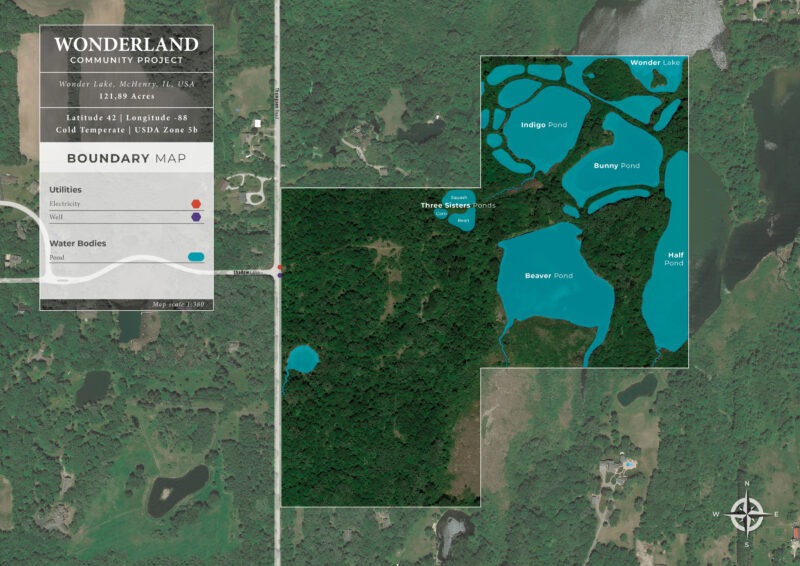
by Oliver Luker*
As a landowner with a keen interest in addressing the climate crisis, this is a question that I have struggled with myself. The moral dimensions alone can be considerable – what is the best that I can do with my land is a very different question from the very best that the land itself can do, for example.
Addressing the climate crisis on your land can involve preserving ecosystems, enhancing landscape connectivity, adopting sustainable practices, and leveraging innovative renewable energy strategies where appropriate. Here, I have attempted to approach the question with a purely pragmatic lens – accepting that emotional and cultural dimensions (amongst others) can also have considerable weight.
Preserve and Restore Ecosystems
Preserving remnant ecosystems must come first, if you’re lucky enough to have this option. In this same bucket we might include restoring degraded ecosystems, with a specific focus on wetlands and forests. This doesn’t mean turning over productive acreage to monoculture forestry, of course. Any approach must emphasize convivial conservation rather than fenced-off preservation, allowing for sustainable human interaction with these ecosystems.
Can productivity and restoration coexist? On our land in McHenry County, Illinois, we are investigating how to incorporate production and increased biodiversity alongside climate mitigation, with methods including:
- Chinampas Systems: Traditional Mesoamerican methods of integrating water and agriculture, which allow for enhanced productivity and maintain ecological balance
- Floating Treatment Wetlands: Seeking to improve water quality in an area with high agricultural runoff, while also providing habitat restoration opportunities
- Non-Timber Forest Products (NTFPs): Creating native food forests / forest gardening systems providing valuable fruit, nut and medicinal benefits
Increase Ecological Connectivity
Permaculture advocates for designing landscapes that integrate natural systems and human needs. Enhancing ecological connectivity is a vital element in this design – increasing the porosity, edges and abundance in landscapes. By leveraging sometimes-forgotten aspects of a property, landowners can address climate change and contribute to landscape-scale corridors connecting fragmented habitats, allowing species to migrate, adapt, and thrive.
Ecological connectivity can be achieved through various means, such as establishing hedgerows, wildlife corridors or stepping-stone habitats that link larger ecological zones. Planting native shrubs and trees along property boundaries can serve as both a windbreak and a migratory pathway for pollinators and birds. Additionally, incorporating agroforestry systems or multi-functional buffer strips can enhance connectivity while improving soil and water health.
Connectivity enhances ecosystem services like pollination, pest control and water filtration. Collaborative efforts with neighboring landowners or conservation groups can amplify these benefits, creating broader ecological networks that support regional climate adaptation goals.
Implement Sustainable Practices
For those managing working lands, implementing sustainable or regenerative practices is crucial. This involves balancing immediate operational needs with long-term sustainability goals. Some methods include:
- Carbon Intensity (CI) Score: This measures the carbon footprint of agricultural production by focusing on annual emissions associated with specific farm activities and outputs. CIS provides a practical framework for operational accounting by targeting short-term emission reductions and offering a comparative efficiency metric for agricultural products. For those interested in growing sustainable fuel feedstock, forthcoming 45Z guidance may provide a way to make money while reducing CIS score.
- Soil Health Investments: Approaches like JADAM (a Korean natural farming technique), biochar application and compost amendments improve soil structure, fertility and carbon sequestration.
- Integrating Trees: Integrating trees into agricultural operations has been shown to enhance biodiversity and carbon sequestration – see Starry Sprenkle-Hyppolite’s work for Conservation International
- Windbreaks and Buffers: Tools like COMET-Planner can quantify the carbon benefits of windbreaks and hedgerows, which also protect crops and reduce erosion.
For those with additional resources, exploring innovative techniques such as fungal inoculation (e.g., from companies like Funga) to accelerate soil health improvement can be a game-changer. Similarly, here again we see that collaboration with others – whether through activist groups or local governmental bodies – is an essential element in building landscape-scale resilience.
Protect Lands
 Protecting both working and non-working lands can provide substantial climate benefits by conserving ecosystems that naturally sequester carbon. These lands often include wetlands, riparian zones and marginal lands that are unsuitable for agricultural use. Acquiring or protecting these areas ensures they remain undisturbed, serving as critical carbon sinks and biodiversity hotspots. For example, purchasing small but ecologically significant wetland areas can enhance regional water quality, mitigate flooding and support habitat conservation for endangered species.
Protecting both working and non-working lands can provide substantial climate benefits by conserving ecosystems that naturally sequester carbon. These lands often include wetlands, riparian zones and marginal lands that are unsuitable for agricultural use. Acquiring or protecting these areas ensures they remain undisturbed, serving as critical carbon sinks and biodiversity hotspots. For example, purchasing small but ecologically significant wetland areas can enhance regional water quality, mitigate flooding and support habitat conservation for endangered species.
When talking about carbon sequestration on land, that soil or biomass carbon can be eradicated quickly through land use change. Accordingly, it is essential to remove as much land as you can from future development – whether through conservation easements, donating the land to a conservation district or through any other permanent legal structure that prevents the land from being cleared and tilled. Landowners might also consider working with organizations that specialize in land trusts to identify key parcels that contribute to ecological health.
Are Renewables a Top Solution?
This question often arises regarding solar panels, with or without grazed animals (“agrivoltaics”), wind energy (micro or macro systems) and perennial biomass for biofuels (e.g., in BECCS or BiCRS). The effectiveness of renewables is typically site and region-dependent:
- Solar Panels: On degraded or low-productivity lands, solar farms can provide significant carbon offsets. However, prioritizing reforestation over solar panel installation on high-potential lands can yield greater benefits over time and certainly are far more complete a solution.
- Wind Energy: Micro or large turbines can reduce farm emissions and supplement renewable energy goals – and of course, site selection is critical to avoid ecological disturbances.
- Perennial Biomass: Used to reduce soil erosion, restore carbon stocks and supply feedstock for biofuels. These systems require careful planning to maximize co-benefits.
Conclusion
To address the climate crisis effectively, landowners should take a holistic approach. Begin by preserving ecosystems, enhance landscape connectivity and adopt sustainable practices. Take action to protect lands (even pre-restoration) from future development – and assess opportunities for renewable energy use. These actions collectively contribute to carbon sequestration, biodiversity conservation and climate resilience.
*Climate Land Leader Oliver Luker is Co-Founder and CEO at Seq Solutions and also co-founder and member of Wonderland Community Project in McHenry County, Illinois.